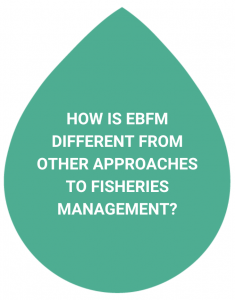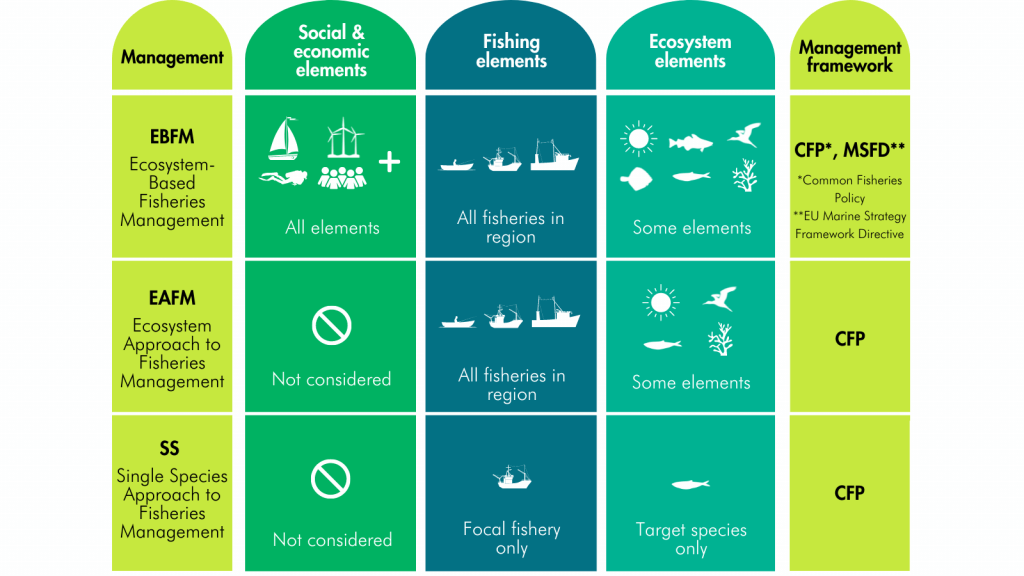“Fisheries management” has many different definitions but, at its core, it is about ensuring the longevity, prosperity, and sustainability of fishing activities, ecosystems, and fish stocks. Over the years, different approaches to fisheries management have been developed and refined. However, with human activities having ever greater influence on marine environments, and with the effects of climate change gathering pace, there is an urgent need to adopt approaches that fully consider the interactions between fisheries and the wider environmental, economic, and social landscapes within which they operate.
Ecosystem Based Fisheries Management (EBFM) is an approach to fisheries management that takes a holistic overview of all ecosystem elements related to fisheries – including impacts on stocks, marine environments, social benefits, and heritage. EBFM acknowledges and accounts for the complex interactions that take place within fisheries by:
Taking account of these interactions and dependencies enables managers to design strategies and test their likely effectiveness in meeting intended environmental, economic, and social outcomes. Imagine, for example, an agency that is overseeing the management of a fishery along a region of coastline that is also important to the country’s tourism and offshore wind industries. Activities by these other industries could affect where and when fishing fleets are able to operate, and could also have their own direct impacts on the marine ecosystem. Using EBFM, the agency would be able to take a holistic overview, using predictive modelling to understand the likely effectiveness of different management measures in enabling the fishery to operate sustainably within the wider context of other human activities and ecosystem processes. With this approach, fisheries managers are able to determine and work within catch levels that will not threaten the long-term sustainability of fish stocks nor other marine species and habitats that these stocks interact with.

The oldest formal approach to fisheries management is the Single Species approach. Single Species focuses on the management of target species only, taking into account catches, biology, and population dynamics. Though it remains the most commonly-used approach to practical species management, the approach has been widely critiqued for ignoring the many and inevitable effects of ecosystem processes, for example, predation by other species, and temperature fluctuations.
As a result, another approach to fisheries management has been to explicitly include ecosystem processes in the management of one or more species, and to be precautionary in management measures – often termed the Ecosystem Approach to Fisheries Management (EAFM). While this move towards greater awareness of overarching ecosystem effects is encouraging, EAFM does not account for social aspects of fisheries welfare, which – under EAFM – are often left to policy-level decisions and rarely considered in scientific processes.
This is where EBFM comes in. Perhaps a little confusingly, different countries and bodies involved in fisheries management sometimes use EAFM to refer to the EBFM approach. However, the key thing that sets EBFM apart from EAFM is that it also incorporates social and economic elements, from both the fishery and beyond, bringing their consideration firmly into the realm of analysis and facilitating their relevance within management decisions. It is this that makes EBFM the most holistic approach there is to fisheries management.

By addressing the environmental, social and economic gaps that exist in other approaches, EBFM is able to fully account for the many different factors that may affect the sustainability of fisheries. It facilitates informed trade-offs between the priorities of different stakeholders, and seeks to optimise the health and productivity of fisheries and their ecosystems in relation to human needs – both now and into the future, as environmental conditions change and human demands on marine ecosystems increase.
Although the benefits of EBFM are widely understood, several core challenges pose barriers to its effective uptake in fisheries across Europe. These challenges include:
SEAwise is addressing these challenges through an extensive programme of research and modelling, framed using four case studies from different regions of Europe that are intended to capture a diversity of fisheries and contexts. This work will culminate in a new tool designed to be immediately relevant to and practicable for fisheries throughout Europe.
The SEAwise Tool will allow fishers, managers, and policy makers to take an EBFM approach in setting and achieving long-term goals that enhance the value of their fisheries for the benefit of all stakeholders, amidst environmental change and increasing competition for marine space. Crucially, the tool will be future-proofed – it will remain responsive to changes in environmental, ecological, economics and social factors, so that users can rely on it to provide consistent and robust advice.
Our dynamic network of fisheries stakeholders is key to SEAwise’s work. We are actively seeking representatives from key management agencies, the fishing sector, NGOs and the scientific community to take part in workshops and other in-person or online knowledge-gathering activities. The shared insights and lived experiences of network members will support the development of a comprehensive understanding of the needs and priorities of a diverse range of fisheries stakeholders, and how to fulfil these.
To ensure that participation in SEAwise is as accessible as possible, SEAwise events will be organised together with participating organisations and will seek to take advantage of existing meetings. Stakeholders who do not wish to be involved with the work of SEAwise at this time are still welcome to sign up to receive occasional email updates, which will share new insights into EBFM as well as details about the project’s progress, training activities, and workshops.
Stay up to date with SEAwise news and research, hear about upcoming events, and receive updates on fisheries news from across the European seascape.